You will need
- roulette;
- level;
- - knife or scissors for cutting metal;
- - nails or screws;
- - hammer;
- - the perforator;
- - pliers;
- - a ladder or scaffolding.
Instruction
1
Veneer siding can give your home aesthetic and well-groomed appearance. However, the material does not require careful maintenance. This is one of its many advantages. The metal siding has a long life, protects the facade from mechanical damage and adverse weather conditions and extreme temperatures. Also important is the fact that thanks to the installation of panels it is possible to insulate the building and improve insulation without losing interior space.
2
Strap metal siding have a special attachment to connect with each other. Due to this, hats of nails and screws are hidden from an external observer, giving a clean façade. To sheathe the house with metal siding yourself, follow the instructions supplied by the manufacturer. So you will save yourself from mistakes, in addition to the pages of the brochure often the methods of laying the panels into complex structural nodes.
3
Inspect the front of the house and remove any items that may hinder the operation. This plants with winding stems, tree branches growing too close to the walls, etc. you Also need to remove the pipes, lights, window sills, water plum and other special or decorative protruding objects. If the facade is wood, note whether exhaust or leaky boards. If Yes, then these shortcomings must be eliminated.
4
Check surface for facing for roughness. If they are, fix them, otherwise, the same bumps appear on the finished facade. Establish a lattice of thin wooden slats. Fill the space inside the cells with preservative to protect from rot, mold and rust, and to avoid deformation of the siding panels. Instead of the antiseptic composition can be laid in insulated material, it will increase the insulation of the house.
5
Start to attach the metal siding from the bottom. Fasten the starter panel around the perimeter of the house. Attach them trying screws or hammering nails in the center of the oval hole designed for this. If they are not enough, then make a new one with a punch. After the entire bottom row, move on to the second, etc.
6
Each bar, first insert the bar of the previous row. For this purpose a special locking design. As soon as you hear a click, the panel is securely attached, you can nail. The principle of installation of the panels, metal siding is designed so that the visible surface has no fastenings. This is due to the fact that the nails are not driven into the panel itself, and in the lower (horizontal siding) or side (vertical siding) strip. Driving in nails, on the pull bar and pressing it to the wall too much, otherwise it will lose its natural shape. However and dangle it shouldn't either. This is the most laborious part of the work.
7
The oval shape of the holes allows the panels to move during temperature changes when the material expands or contracts. For this purpose leave a small distance between the nail head and the surface about 1.5-2 mm. If in the circumstances you need the installation in the cold season, make the gap even more.
8
Cut panels with a knife or a metal saw with fine teeth. In the future when you return to the metal cladding of previously deleted objects, make holes in panels of larger diameter by 3-5 mm than required.
9
The corners of the building the ends of the panels connect with a special outer corners. Around window frames, door frames, and top edge use the J–strap. They got the name for that capital letter of the Latin alphabet due to its shape, which allows you to produce neat edging.
